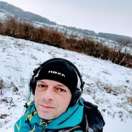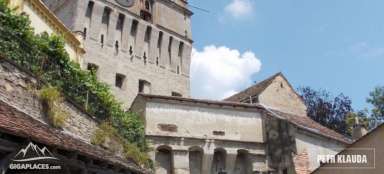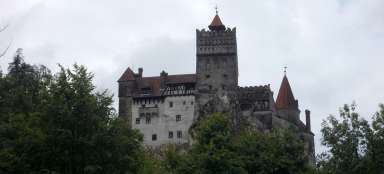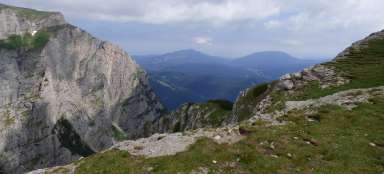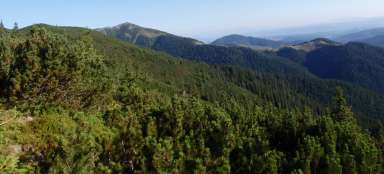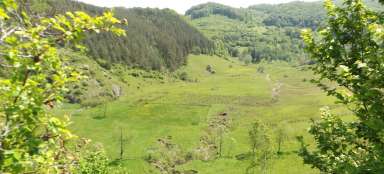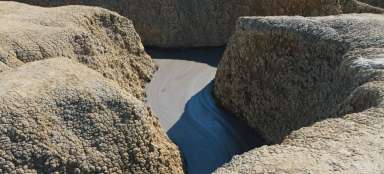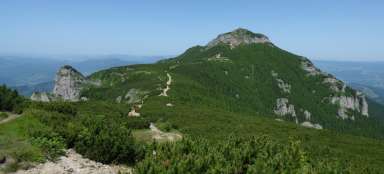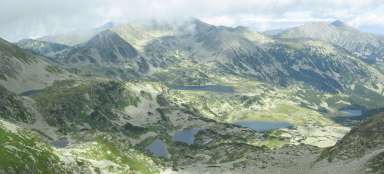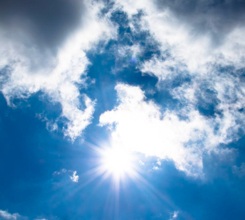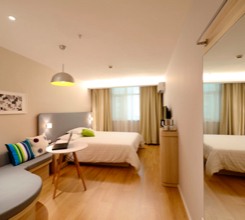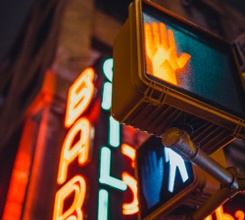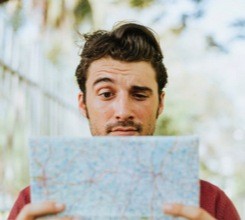Wild mountains in Rumusnek

Fagaras, from Romanian as Rain Mountains, which I can confirm. The transition took us nine difficult days
8.7 2018, day one
Breaza - Cabana Urlea
There are eight of us. The bus throws us out in the village of Breaza, which lies below Fagaras at an altitude of 600 m above sea level. It's 9 o'clock in the morning. We take off our sandals and our swollen feet, from long longings with the bus, we literally dig into the mountains. We have a hard time, because Fagaras is perhaps the last wild and desolate mountain range in Europe. So far, they have not allowed any development companies to build the infrastructure and build hotels, resorts and cable cars. You do not have the opportunity to buy more food on the ridge. There is nothing there, only the rocks. Due to this fact, you feel there yourself. There are no crowds of tourists, tourism and other signs of civilization. So everything we needed for the ten-day crossing of the seventy-kilometer ridge, we pull in a backpack on the back, which weighs about 27 kg. We are spared the most needed and at the same time the heaviest load – water. There is plenty of water in the mountains and at least once a day it is possible to replenish it from mountain streams. However, before drinking, it is necessary to sterilize the products that you normally buy in a pharmacy or e-shop. I have good experience with Sanosil drops, which are also used by our army. If you treat the water from the pool with this, you can easily drink it. There are numerous herds of sheep grazing in the mountains, so it is necessary to sterilize it. But back. After the landing in Breaze, we immediately set off along the red road to the hills, to the Cabana Urlea hut. We have 10 kilometers ahead of us, which is not much, but due to unpaved roads (you won't find others in Fagaras), back strain and 1000 meters of altitude to climb, we are blowing like crowded boilers. From a slight ascent along the stream and further through the forest, it becomes a rough path against the contours. During several hours of a painful and steep climb, one will encounter almost everything here, from wading through a stream, jumping through swamps in the woods, sliding in the mud, to balancing on rubble. We go on the move and we get to the cottage around noon. If you're waiting for a chat, like a chat, you're wrong. This cottage is just an almost dilapidated ruin, which has not been in operation for several decades and is just falling into disrepair. It lies at an altitude of about 1500m.nm, just below the sharp rise to the ridge. There is a more spacious flat terrain where we set up tents. A fairly decent downpour starts almost immediately. We crawl into tents and, destroyed after a strenuous ascent and the previous night spent in various, unnatural positions in the bus, we immediately fall asleep like logs. Around 5 pm we all start waking up. The rain is still pounding on the tents. We take cookers and various chemically modified instant foods and run into the torso of the cottage, where we each have something crazy. At about 20 o'clock it stopped raining and the clouds parted. Only now we have the opportunity to see two massifs of peaks Mosu (2231m.nm) and Somnului (2385m.nm) and a massive ridge. It made my head spin. They are only four kilometers as the crow flies and a kilometer higher than us. And in the morning we have a climb to the ridge between these two monsters. In the wet, cold (it was 6 degrees) and at full load. He goes to bed around 9:30 p.m. It's starting to rain again. 7/9/2018, day two We get up at 8 in the morning. It's not raining, but it's foggy and poor. Temperature about 8 degrees. We descend from the hill, to a stream about half a kilometer away, we replenish our water (I recommend hydrovacs), we brush our teeth and more daring individuals undress and climb into the icy water of the mountain stream. I return to the tents, we eat something, we drink tea and coffee, we pack tents and all the shops and skins with it on my back. The first hard day awaits us, the most physically demanding of the whole transition. We set off and it starts to rain. It hasn't been here long. We put on raincoats. The ascent to the steep ridge and streams of water roll against us, which takes down mud, rubble and smaller sticks. Again, we claw against the contour lines. We are rested, so we can set a sharper pace so that we have the ugly section behind us as soon as possible. The trees have disappeared and we are climbing in mixed terrain. Kneeling alternates with mud, mud with stones and stones with grass. All the time, three hours straight. Not much in heavy rain. Finally we get to the saddle, between the peaks of Mosu and Somnului. Great. The worst stretch behind us. It stops raining, and we take off our raincoats. We take a lunch break, which features some canned, durable salami and an energy bar. The mood improves as the sun rises. Not for long, but it warms our bones for a while. I take out the SLR and take the first photos from the ridge. The height of the ridge never falls below 2000m.nm. After a break, we pack up and continue, more or less just along the ridge. After a while, we meet for the first time a herd of sheep and herding dogs that behave aggressively. Two of them run to us and look like they want to attack. Fortunately, there is also a bača who calls them back. The road is clear. We cross a vast rocky plain and come under the top of Somnului. With a steep rise we get about 200 meters higher and traverse along a narrow rock shelf to the first exposed section – a sharp ridge that connects the Somnului massif with the Urlea massif. The path is narrow for two fingers and on both sides there is a gap of about two hundred meters into the walls. Who suffers from dizziness and fear of heights, do not even come here. There is no security here. Along the way, we meet a couple of crosses battered from slats, in memory of the people who crashed into the wall here. That doesn't add much to the smile. We continue to cross three more peaks, Mogos (2398m.nm), Cheia Bandei (2381m.nm) and Coltu Balaceni (2286m.nm). The descents are quite dangerous. Wet, rocky terrain and mud that slides like a pig. At around 5 pm we descend to the saddle between the peaks of Colta Balaceni and Bacon. There is a shed (otherwise refugee) in the saddle, where you can spend the night if it is not already occupied. But Fagaras is really deserted and the shed is empty. So we bucket inside. There are six bunk beds without mattresses, only skeletons with mesh, and two Umakart tables, about twenty years old, one large and two small windows. The door is missing. Well, at least we didn't go down without explaining ourselves first. I throw my backpack into the corner, stretch the mat and sleeping bag on the mesh and take the position of a lying shooter. The others immediately monkey. We lie and talk for about an hour. Then we get up and cook dinner. We hung wet rags on the bunk beds, naively thinking they would dry by morning. I'm going to explore the surroundings. To the north of the hut is about 5 meters distant edge of the saddle. Then only a few hundred meters into the valley. We came from the east and to the west there is a climb to the top of Slanina. To the south lies a vast valley where water can be heard. I walk about 300 meters down and discover a mountain stream. Great, there's water here too. I'm going back to the shed. Suddenly a friend says that someone is coming down from Colt Balaceni. We climb out and wait. They are three boys, Czechs. From somewhere in Pilsen. They are fine. They climb into our shed, the bunk beds are still free for them and they talk. They pulled rum from a backpack, a Moravian friend pulled out a homemade plum brandy, and that evening was merry. We go to bed late, I guess around 1 o'clock. We don't have to work hard and there is a barking in front of the cottage. A dog as big as a calf. Sheep are nearby. We can't take over, the dog is still barking and we don't have a door. But he doesn't dare go inside. We wait about half an hour for him to leave. He's not leaving. So we take headlights, trekking poles and we have to climb out, until that winter. We drive the dog away and finally fall asleep. 9/10/2018, day three I'm waking up. I don't see anything, it's absolute darkness. I'm fiddling with the phone and looking at the time. It's 4 o'clock in the morning. I slept for two hours and, strangely, I feel good. Everyone around is fast asleep. I'm still trying to work, but I can't. I get out of my sleeping bag, put on my pants and a warm jacket, slip into scandals and slip out of the shed. Then I throw back and return for the headlamp. It is absolutely dark outside. I'm afraid I won't step into space, a few meters from the hut is the deep abyss into the valley. I don't want a cross battered with slats. I sit in the grass on the very edge of the saddle and turn off the headlight. Strange feeling when I know there is a lot of depth under the ground, but I can't see it. The sky is clear and millions of stars are flashing at me. There is no light smog that would disturb the beautiful spectacle. Silence is absolute when it seems threatening. My eyes got used to the darkness, and I could make out the silhouettes of the two jagged peaks. They look scary. In this scenery – the endless sky, the crazy silence and the spooky mountain peaks … One realizes how tiny and helpless he is. That he is not the master here, as many think. If nature could destroy humanity, it would. And we can't do anything about it. She doesn't need us. We need her. When we destroy nature, we die with it. When humanity dies, she will remain. She will move on. As I sit here and various things run through my head, I begin to feel that I have completely icy toes. I suspect they may be 2 degrees above zero (in July!). I get up and relax back in my sleeping bag. I fall asleep immediately. The talking of others wakes me up. It's 8:30. Today he is in no hurry. Today will be rather undemanding. I take a hydrobag and a plastic bottle and go down for water. I make tea, coffee and eat biscuits and cheddar and dried beef. As a dessert, I have an energy bar again. We pack the shops, say goodbye to the Pilsen people who are still left and set off. Again a sharp lift from the saddle to the ridge, but nothing terrible. We're upstairs in 15 minutes. We descend the top of Bacon and put on our raincoats again, because it is starting to rain. The terrain is quite ok. From Bacon we descend against the contour lines and descend by about 200 meters, to the saddle of Fereastra Mica and Sambetei, so that we can then ascend 300 meters to the top of Galasescu Mic. When descending from this peak, the first rock sections with chains and steel ropes appear. It's nothing complicated, it's just uncomfortable with the heavy rat on his back. Now another ascent, this time just below the top of Galasescu Mare, from where we traverse the mixed terrain below the top of Galbenele. This is followed by a descent into the saddle and the first crossing of a fairly large firn field, which is on a fairly steep slope, so we have to be careful. One slip and you drive your butt a few hundred meters lower, into the valley. If it doesn't beat you up on rocks or throw you out of the gutter, you might even survive. We have the peak of Hartopul Ursului in front of us, where we take a break because it has stopped raining and the sky has broken. It's just 2 p.m. We sit on the gravel, we snack, we talk, we enjoy the views of the whole mountain range and I take pictures. The massive Moldovean massif (2544m.nm), the highest mountain of Fagaras and at the same time the whole of Romania, which we should climb today, rises in the distance. We've been sitting here for almost an hour. We pack the shops and go to the descent. We go down and go up again. Up, down, up, down, rocks, chains, mixed terrain … all the time. The peaks of Vistea Mare, Corabia, Podu Giurgului and even the highest Moldoveanu are behind us. Today it works for us. Probably yesterday's doping from brandy. We get to the saddle of Saua Podragu, from where we descend to Lake Lacul Podragu. The descent is very steep and long. I even beat myself up a bit. Fortunately, it was just above the rock plateau and I had nowhere to fall. After all, after the rain, the terrain was muddy and it slipped like hell. I took one longer step, it took me and I was already flying. I fell on my side and the heavy backpack on my back worked wonders for me. She rolled me as she pleased and I couldn't slow it down. She got me into a few somersaults, and I stopped a short distance below, on a rocky plateau that fortunately had a raised edge and formed a counterweight. The inertia is insidious. I only carried it away with a frayed hand. Fortunately, I had the trekking poles off, so I let them go when I fell. To those trekking poles – if you don't wear them, try it. Thanks to them, you keep your back straight and move the whole torso. They help with the ascent, when thanks to them you pull a quarter of the weight with your hands and your knees do not hurt when descending. Wear them free during the descent. If you fall, you will avoid sticking to them. Do not use them just when descending rocky sections and chains. They get in the way and you can trip over them. So I fall and after falling I get up and continue my descent. After about an hour we reach the valley to the lake, which is sandwiched between the peaks on all sides. It is dark and cold here, the sun shines here only two hours a day. Firn and ice are everywhere. By the lake stands the hostel Cabana Podragu, where we intend to sleep. We will be welcomed by a nice lady with her daughter of about 15 years. Both have excellent English. If you are waiting for a standard that you are used to from the Czech Republic, then wake up. Despite the winter that prevails in the valley, he does not drown in the cottage. There is no shower or hot water. The toilet is Turkish and dirty. The room we share with 20 young Frenchmen has old, ripped bunk beds. My lady and I agree on the price of 20 Lei per person per night with dinner and breakfast. So we stay and go to a kind of common room. There are only large wooden tables and benches. We are warmly dressed, steam comes from our mouths. We're getting dinner. Rice with pork on mushrooms. If it didn't smell like anise, which they add to everything, it would be nice. After dinner, we have Romanian beer and their homemade brandy, similar to our plum brandy. We talk, we talk and we talk. We find out it's 22 o'clock and we go to bed. I fall asleep immediately and sleep until morning. 11.7.2018, day four At 7 in the morning we are woken up by the screams of our French roommates. They get dressed, pack their shops and leave. None of us want out of bed. We have soft mattresses under us and a pillow under our heads. Covered with a thick blanket and his sleeping bags. The room is cold in the morning like in a freezer. We gradually go to the bathrooms, we wrap ourselves in wet and cold clothes (the reserve dry has already occurred), which will probably dry up in the Czech Republic. It doesn't dry here in the mountains. This is not possible even in cold air with high humidity. However, the worst is the cover of ice and soaked fusekle and wet hiking boots. We pack the shops and go to have breakfast. It's after breakfast and the lady comes with a bill. Suše tells us that she had to increase the price, each by 8 Lei (!). Without consulting us in advance. We don't want to spoil our mood with an argument, because even with the higher price, it's cheap, and we pay. We have a sharp ascent to the ridge, which we complete without any problems, within an hour. It's not raining yet, the weather looks great. We traverse through the wall to the top of Podrag (2462m.nm) and head to two peaks connected by a sharp ridge, Mircia (2470m.nm) and Arpasul Mare (2468m.nm), from which we descend 400 meters below the saddle and further along the sharp edge of the ridge , without major height differences, to the beautiful Lake Lacul Capra. This section is probably the least demanding. Every now and then we stop, take pictures, dig up mud from the mountains or just take it off. We cross a few firn fields, descend several rocky sections secured by a chain and a rope. We have a large time reserve and my girlfriend and I decide to take a longer break for a snack and another photo shoot. The others go ahead. After about half an hour we get up and continue. We get to the horizon of the ridge and in the distance we see six dots crossing the firn field. They are ours. I had noticed before that the distances in the mountains, measured with the naked eye, were deceptive. You see an object you're aiming at. You say you're there in five minutes. In fact, the journey will take you half an hour. The six dots just enter the top wall. We say to ourselves, „Where the hell are they going? It's completely vertical.“ After another half hour, we cross the firn field as well and find ourselves under the wall. It is not vertical, but very steep and rocky. I clean the sticks for the ascent, because we have to use our hands as well. The climb takes about three-quarters of an hour. Ours are waiting for us upstairs. We give a five-minute rest. Along the way we meet two flocks of sheep. Greetings with bača. Surprisingly, the dogs don't notice us this time. We are approaching the famous comb, which bears the poetic name „Three Steps from Death“, (La Trei Pasi De Moarte). We know that a Czech tourist and her boyfriend died here recently. They fell into the wall. They have monuments here. Not exactly a pleasant feeling … Well, nothing, let's move on. We cross the ridge, climb ropes and chains and cross another firn field. It starts to rain slightly, but the sight of the sky does not bode well. After a few minutes the rain stops and in front of us appears the beautiful lake Lacul Capra, supposedly the most beautiful in the Romanian mountains. It lies in a valley enclosed by the peaks of Lezerul Caprei (2418m.nm) and the peak of Vanatarea lui Buteanu (2507m.nm), between which is the saddle Saua Caprei. We set up tents on the shores of the lake. The sky turned blue, the sun peeked out, and we enjoy the green valley, blue lake, and rocky peaks that turn the setting sun red and orange, on which sheep graze. We all grow outside in front of the tents, we sit on mats and we each prepare some dinner. My girlfriend and I cook instant chicken on curry with noodles. There were noodles, curry too, but not chicken. Personally, I think that the presence of chicken would not enhance this dish much. I do not believe that it has the slightest nutritional and nutritional value. But you can survive on this diet for a few days. It's after dinner and we make tea and coffee. A couple of brave individuals undress and climb into an icy lake. The others remain unwashed. We sit, talk and time runs out. It is suddenly dark and 22 o'clock. We crawl into tents and fall asleep. 7/12/2018, day five My girlfriend wakes me up. I open my eyes and for a second I don't know what's going on. It's dark, she shines a headlight. He says something is near the tent. We hear sounds like someone pulling something on the ground. I only get out of my sleeping bag in my shorts, I take a headlamp and a trekking stick. I open the tent and suddenly silence. They're coming out. About 5 meters from the tent lies my, almost thirty kilos backpack. My girlfriend's torn hydrovak is a short distance away. Fortunately, Krosna remained whole. I don't know if it was a wild dog that roams a lot here, or what it was. Maybe a wolf. Certainly not a bear, because he would do another theater. But it was something bigger when it dragged the heavy backpack a little further. Namely, we left the backpack and a few things under the tent shelter overnight. As we lit up the tent and started talking, it escaped. The sky full of stars, absolute silence, nothing anywhere. Everyone is sleeping. I walk between the tents for a while longer. Then I climb into the tent and fall asleep again. It's 2 o'clock in the morning. Around six, we are awakened by some kind of bells. I peek out of the tent and sheep march right in front of my nose. Amazing. We take a camera and climb out. I photograph this large herd descending from the summit of Vanatarea lui Buteanu. In the distance, it looks as if someone has thrown a white bushy carpet over the top. There are so many sheep. They pass between our tents and climb and the opposite peak of Lezerul Caprei. Among them are several huge shepherd dogs who ignore us. They have enough work to look after the sheep so that they don't run away. Bača comes last. Tall and burly guy. A ram on his head, sheepskin over himself and a raincoat on top. Backpack on the back. He is carrying something in his arms. It's a torn sheep. She's already dead. He says it was a wolf. The dogs finally entered him. But he tore one sheep enough to bleed. Sheep and dogs stay in the mountains for the night. Bača just goes to sleep in the valley and returns to the hills in the morning. So we already know who visited us last night. None of us are going to sleep anymore. The sky is blue and the light from the rising sun is refracted by the rocky peaks of the mountains. The sheep disappear into the wall of the opposite peak. We start cooking breakfast and think about how to do it with the destroyed hydrobag. It's quite a loss. Either my girlfriend and I will share mys, but we will have to constantly look for water somewhere to replenish, because 3 liters of water a day for two is damn little. We don't even have a plastic bottle that can carry water. The only solution is to jump over the Saua Caprei saddle and descend to the other side deep into the valley to Lake Lacul Bâlea. There is a large tourist resort with several hotels and shops. Maybe we can get something there. The famous Transfagarasian highway ends there. Known, for example, from the show Top Gear. A road full of curves and a serpentine, crawling from the foot into the high mountains. So the plan approved. We pack tents and shops, climb into the saddle and descend to Lacul Bâlea. From the saddle you can see into the deep valley to the lake and the resort. Krpál is much more difficult than to the icy Lake Lacul Podragu. Some sections we have to descend on rock shelves and somewhere there are holes that we have to jump over. After about half an hour we're down. I'm not looking forward to going back at all. It's 500 meters down and then up again. And tomorrow we will climb the second highest mountain in Romania, which bears the name Negoiu with a height of 2535m.nm. It soon turns out that the descent to Lacul Bâlea was not a bad idea at all. We enter a shop with sports equipment. I don't even hope they know what to imagine under the term hydrovak, but I ask the salesman. And lo and behold, he pulls two sizes off the shelf. I take the bigger one, three liters from the stain. Eureka, the biggest problem is over. We get out of the store and look around. The smell of grilled sausages and cheese hits us. All we have to do is look at each other significantly. We don't even have to talk and we take stalls with goodies by attack. We roar like greedy grasshoppers. He will have baked sausage, he will have grilled cheese, he will have kebab, he will have polenta and he will have a piece of everything. We drink it all with draft beer. Although Romanian, but today we feel that we have never drank better in life. They also have real espresso here, but we prefer Romanian special iced coffee, very strong and very sweet. Finally, we drink their Palinca brandy. It is a double distilled brandy made from a mixture of fruits. This one had 60%. We don't have much time, so we buy some sausages and cheeses with us, throw the backpacks on our backs, add water and climb into the saddle from which we came. Thoroughly strengthened, it works for us. We're upstairs before we're downstairs. But that's the way it is. The descent is always worse than the ascent. From the saddle we run to the top of Lezerul Caprei and then descend 400 meters again. Then we just traverse to the top of Laitel (2351m.nm). Along the way we meet several flocks of sheep and once we are attacked by dogs. But just stretch the trekking stick and the dogs will be removed to a safe distance. We take a short break at the top. It's 3 p.m., and heavy clouds roll over the ridges. It looks like rain. And yes. Still at the top, a strong icy wind blows unexpectedly and begins to fly like a can. We put on raincoats and fall down as fast as possible. Before we can descend, the rain and wind will stop. As soon as it came, it left just as quickly and the sun peeks out again. The weather in Fagaras is really very unpredictable, like a woman's mood. Below the top, we climb the slope and complete the mixed traverse again, all the way to Lake Caltun, where we will spend the night. We set up tents, cook, talk and go to the corner at around 9 pm. 7/13/2018, day six At 7 we get up. The night was quiet. A little shower. We climb into the winter and fog. We cook, pack and calm down. In the fog, it doesn't look a little sympathetic here. Today we are waiting for the dreaded Negoia. Just as Everest is a few meters higher than K2, so not as dangerous as K2, Moldoveanu is also a few meters higher than Negoiu, but climbing the Negoiu is more dangerous and insidious. From the lake we go up a slight ascent to a sharp ridge, which we cross and Negoiu is in front of us. We can go up either with a rubble trough, which is not so technically difficult, but it is long and physically demanding. We choose the second option and that is the ascent through the dreaded Drunga gorge (Strunga Dracului). We clean the poles into backpacks, tighten the backpacks firmly around the hulls and start climbing. It is a relatively long and almost perpendicular section of rock in a rock gorge, secured by a rope and chains. But it doesn't seem dangerous to us, as they say. The technical difficulty is not high and the ascent should be handled by every intermediate tourist. It is more of an unpleasant feeling that there is a gap several hundred meters deep under you, which you have right under your ass. But if you hold on tight and watch where you step, nothing will happen to you. We get to the top of Negoiu without complications. We stay here for a few tens of minutes. We have a lighter meal, take photos and enjoy the views. Then we start the descent, which is already quite a mouthful. It leads along a sloping, narrow rock shelf, next to which a waterfall rolls down. Wet gravel slides a lot. With our butts clenched, we get down successfully. We start climbing up again, this time through a rubble trough and we cross another firn field. We climb to the next peak of Serbot (2331m.nm). A rough stony path leads to it, which doesn't really look like a path at all. We will swing over the top of Serbota and descend to the new, tin refugee bivouac, where we will spend the night. These bivouacs have a huge advantage. They have bunk beds, without mattresses, but you don't have to lie on the cold ground, if it's raining, you're under a hard roof and you don't have to crouch in a small tent, and most importantly you don't have to set up a tent and repack it in the morning. Under the bivouac we find a spring of water, which is invaluable. We cook again, talk and fall asleep around 10 pm. 7/14/2018, day seven At 8 we get up, cook, add water, pack and set off to meet new horizons. We ascend, descend, alternate mixed terrain with rocky and here and there with the firm. We meet flocks of sheep again, we traverse again. Here we take a break for food and take photos along the way. This is how we get to Lake Avrig in the evening, where we set up tents. We cook again, talk and lie down around 10 pm. 7/15/2018, day eight We get up again around 8 o'clock. The last day in Fagaras. Today we have a really long way to go, to the village of Sebesu de Sus. The road that only leads down. We have a descent of almost 1,700 meters down. The first kilometer is a sharp downhill. Then we descend only slowly, but even longer. We meet sheep, take breaks and at an altitude of about 1500m.nm trees begin to appear. At the same time, it is noticeably warming as it falls. While above the temperature never exceeded 10st. Celsius, so at an altitude of 1500m.nm is 20st. Celsius. We enter the forest, cross the meadows and the sun is already starting to burn quite a bit. We turn towards the ridge. Heavy clouds roll over the mountains and it rains there. Here's a steamer. Along the way, we scare off a lot of vipers. In the evening we finally get to the village, which lies at an altitude of about 450m.nm. There are 34st. Celsius. There is no value in building tents. We go to a local pub and then bathe in a stream, the water of which has a pleasant 25 degrees. We go outside the village, throw mats on the ground and fall asleep. 7/16/2018 day nine We wake up around 9 o'clock. We go to the shop for fresh pastries and have breakfast. At 11 o'clock we leave by bus to the beautiful city of Sibiu, from Sibiu to Brasov and back to our beautiful Czech country. As we have had the opportunity to get to know Romania in the first and last days, I must say that it is a beautiful country. Especially the countryside, which is not much affected by civilization. And those mountains … are really virgin. Fagaras can be compared in height to the High Tatras. But in the Tatras you walk along the ridges on paved roads, meet hordes of tourists and at any moment you come across a cottage. In Fagaras it is the opposite. The roads are unpaved, you often have to improvise and you will rarely meet tourists. In the whole 8 days on the ridges you will meet a few people, which you will count on the fingers of both hands. And if an injured or torn hydrovak does not force you to descend the ridge, you will not come across any huts. In Fagaras you will most often meet sheep, shepherd dogs and chamois. Just a fairy tale. Fagaras is vast, rugged, majestic, and just looking at it inspires respect. In conclusion, I want to thank these mountains. I entered Fagaras with respect and humility and left with thanks. Fagaras will not give you anything for free. At a minimum, it will take a lot of your energy as many times as you fail to shut up. Many times the question of why climb has been said. Why the brutality. We keep scrambling to the tops completely destroyed and exhausted. Some people pay the highest tax for this. Unfortunately. It never occurred to anyone to pack their five plums, turn around, and just leave. There is no start and finish line in the mountains. There are no cameras or spectators. It is not consumption. This is the heart. We don't climb for others. We're climbing for ourselves. We don't need to prove anything to anyone. The mountains are unfettered, unexpected and unyielding. But if you enter them with respect and reverence, they will reward you generously. In the mountains, and perhaps only in them, you will only know your strength and your weakness. In the mountains, everything is pure and real. Often to the extreme. So THANK YOU again. PS please do not forget the rule that what you bring to the mountains (and not only to them), then take with you. If there is an area where entry is prohibited, respect this. There is a reason for this ban. This will avoid injuries or disturb the local fauna and flora.
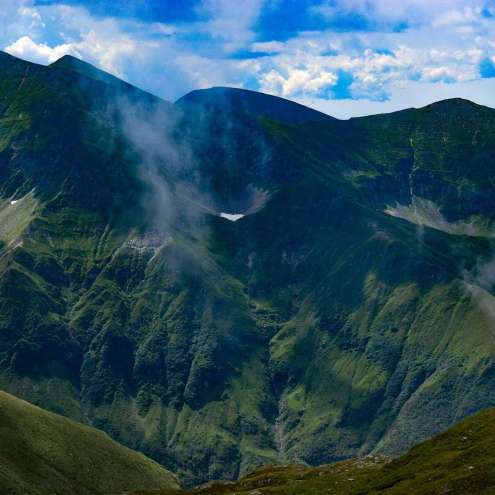
View of the wall of Moldovenau
After the storm
Comb
This can also be skipped
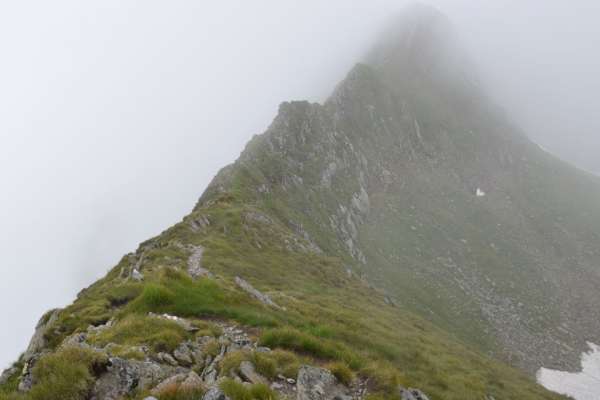
Crossing the Fagaras Mountains
Some alpine flora :-)
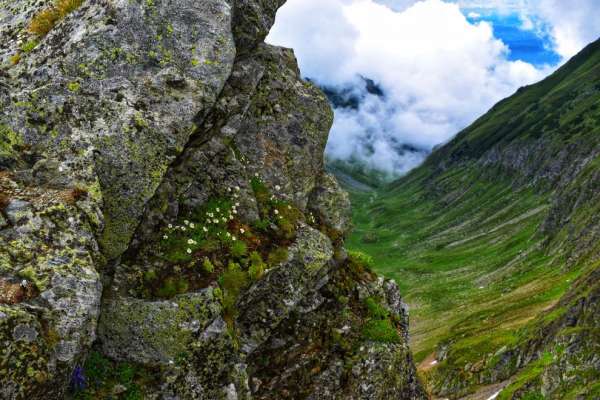
Crossing the Fagaras Mountains
Galasescu Mic

Crossing the Fagaras Mountains
Serbota
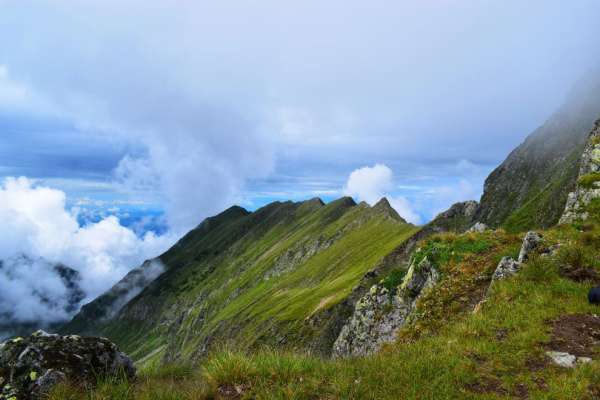
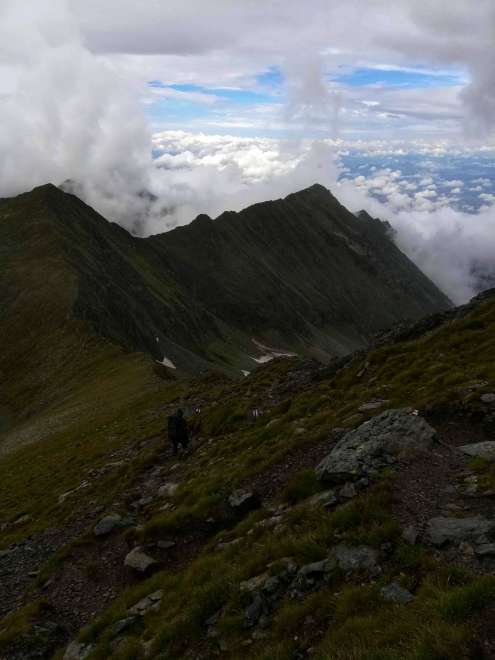
Crossing the Fagaras Mountains
Just before the storm
Crossing the Fagaras Mountains
In the saddle near Podrag

Crossing the Fagaras Mountains
After the first climb to the ridge

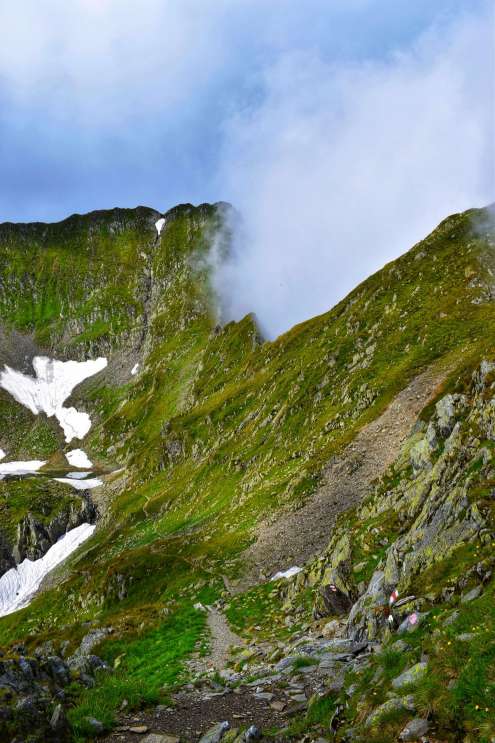
Crossing the Fagaras Mountains
Before boarding the wall of Colt Balaceni.
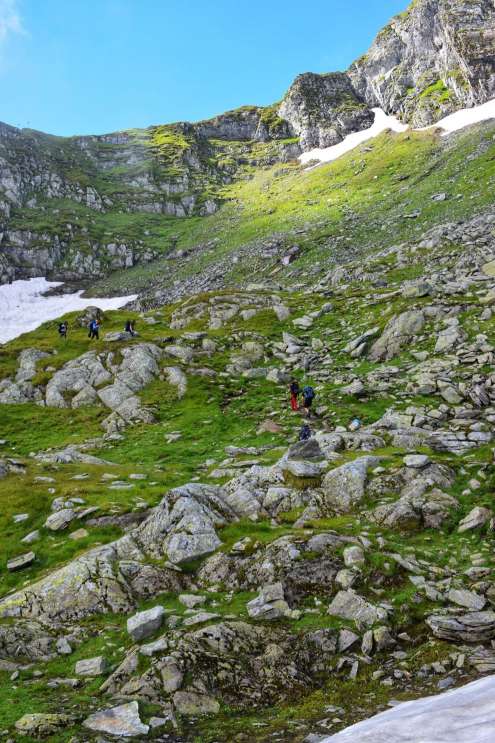
Crossing the Fagaras Mountains
.

Crossing the Fagaras Mountains
The first rock face seems close, doesn't it? So pull the photo. An illustrative example of how deceptive distances in the mountains are :-)
Crossing the Fagaras Mountains
GPS location search

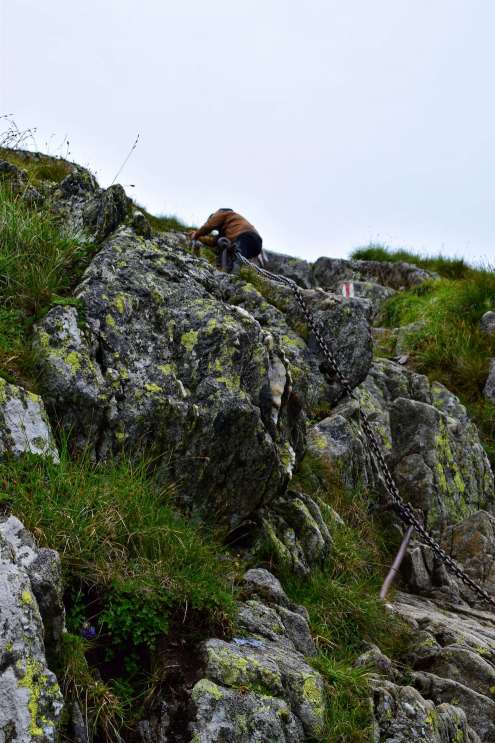
Crossing the Fagaras Mountains
The first descent on chains
Crossing the Fagaras Mountains
A moment from the bivouac
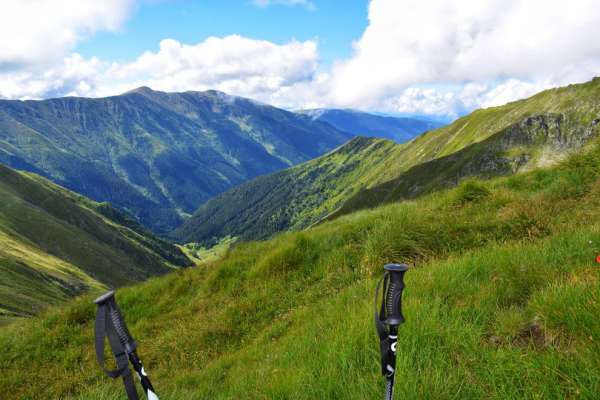

Crossing the Fagaras Mountains
This is what the roads in Fagaras look like. Marking only. No groomed and paved trails.
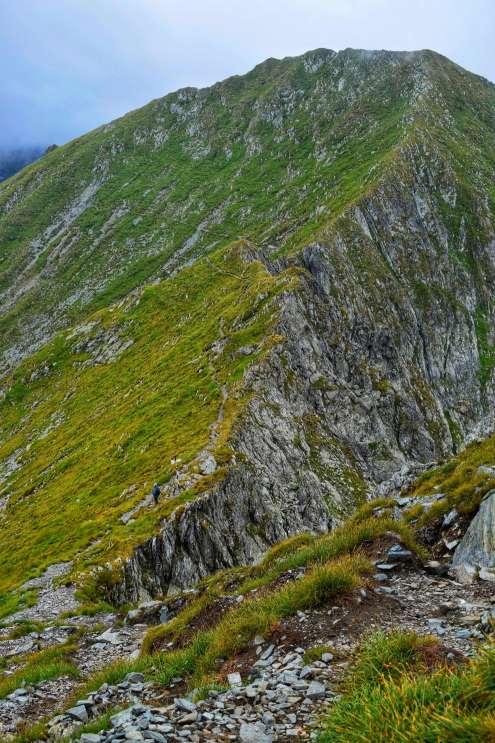
Crossing the Fagaras Mountains
Along the edge of the Slanina peak up and in two thirds you go to a traverse.


